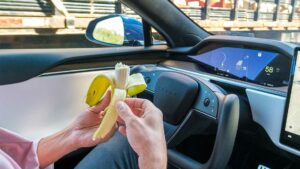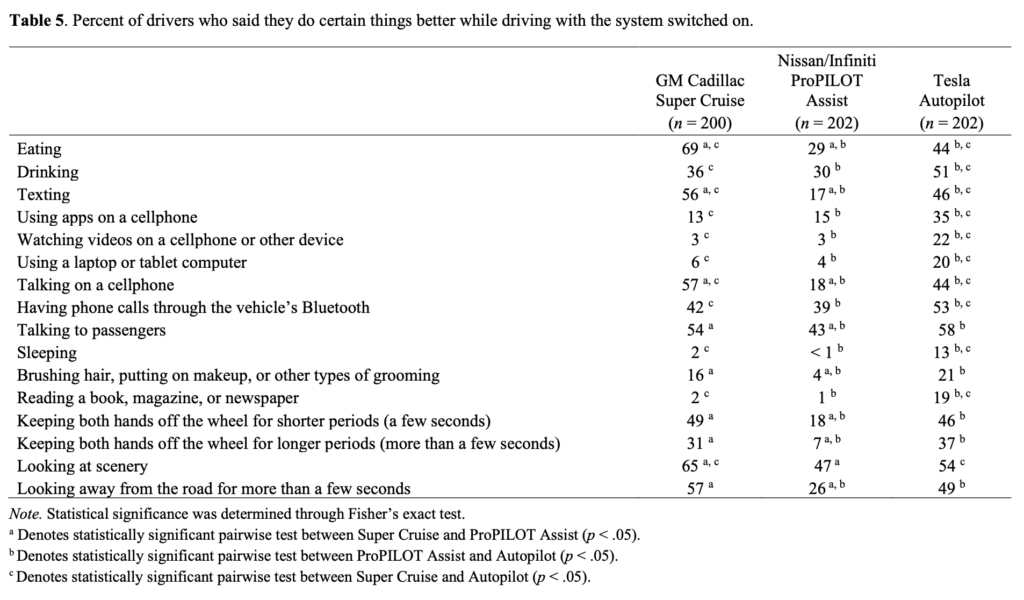
IIHS study finds many drivers treat partially autonomous vehicles as self-driving
By onInsurance | Technology
Drivers who use partial automation frequently treat their vehicles as fully self-driving, confident that they can perform non-driving-related activities like eating or texting while behind the wheel, according to a new study by the Insurance Institute for Highway Safety (IIHS).
The institute said it conducted the study, “Habits, attitudes, and expectations of regular users of partial driving automation systems,” to better understand how automation influences drivers’ perceptions of non-driving-related activities and the likelihood that they will engage in them.
“[T]his study contributes something new by providing an in-depth exploration into the attitudes and expectations of regular users of the technology, how those expectations contribute to habits behind the wheel, and how those habits relate to specific system design characteristics and safeguards,” the the study’s author, Alexandra Mueller, told Repairer Driven News.
While not the first study of the issue, “it does add important data that underscores the crucial role of safeguards like driver monitoring and attention reminders,” Mueller said.
Contributing to the problem is that some driver assistance systems are likely to give drivers the impression that they’re more functionally capable than they are. That confusion can lead to a false sense of security and a higher degree of engagement in non-driving activities, IIHS said.
The study concludes that “Multifaceted, proactive user-centric safeguards are needed to shape proper behavior and understanding about drivers’ roles and responsibilities while using partial driving automation.”
Researchers surveyed just over 600 drivers, evenly split among regular users of General Motors’ Super Cruise, Nissan/Infiniti’s ProPILOT Assist, and Tesla’s Autopilot. It found that these drivers were more likely to perform non-driving-related activities while using their partial automation systems than while driving unassisted.
“More worrying, 53 percent of Super Cruise users, 42 percent of Autopilot users and 12 percent of ProPILOT Assist users said that they were comfortable treating their vehicles as fully self-driving,” IIHS said.
“The big-picture message here is that the early adopters of these systems still have a poor understanding of the technology’s limits,” IIHS President David Harkey said. “But we also see clear differences among the three owner populations. It’s possible that system design and marketing are adding to these misconceptions.”
The study found differences among respondents. For instance, more than half of Super Cruise users said they were comfortable letting the system drive itself without having to watch what was happening on the road, compared with about 40% of Autopilot users and only 12% of ProPILOT Assist users. Super Cruise users “were also far more likely than the other two groups to say that most non-driving-related activities were safe to do while using the system,” the study said.
Super Cruise users were most likely and ProPILOT Assist users least likely to think that secondary activities were safer to perform while using their systems, according to the study.
“When using the automation, certain activities, such as eating, using smartphone apps and grooming, were much more likely among Super Cruise users than the other two groups, compared with while driving unassisted,” the study said. “Super Cruise users were also more likely to report having their hands off the wheel and looking away from the road while using automation. In contrast, Autopilot users were more likely to watch videos, use a computer, and read while using automation than the other two groups. Both Super Cruise and Autopilot users were significantly more likely to take their hands off the wheel, use peripheral devices, and look away from the road while using their systems than ProPILOT Assist users.”
Likely contributors to those differences are system design and marketing, IIHS said. It noted that TV commercials for Super Cruise show drivers patting their laps and clapping their hands along with a song, while Autopilot conjures the systems used by commercial airplanes. “In contrast, the name ProPILOT Assist suggests that it’s an assistance feature, rather than a replacement for the driver,” the institute said.
While all three systems are considered Level 2 systems under the SAE’s definition, Super Cruise offers hands-free driving under certain circumstances, while Autopilot and ProPILOT Assist require a hand on the wheel at all times.
Previous research has shown that “Over-trusting either hands-free or hands-on-wheel partial automation can lead drivers to not intervene even when they see a hazardous situation forming in front of them because they incorrectly believe the system can handle more than it was designed to do,” the study said.
Researchers asked about drivers’ attitudes toward user safeguards, such as reminders to pay attention to the road while using driver assist systems, or system lockouts that would be triggered if the driver ignored those reminders. “While some drivers said they found the safeguards annoying and tried to circumvent them,” the study said, “most people said they found them helpful and felt safer with them.”
Around 40% of users of Autopilot and Super Cruise, the two systems with lockout features, reported that their systems had at some point switched off while they were driving and would not reactivate. Conversely, a substantial portion of ProPILOT Assist users reported that they had never even received an attention reminder.
“The broad acceptance of attention reminders and system lockouts suggests not only that they have the potential to make it safer to use partial automation, but also that they could be implemented more widely to help combat driver distraction in general,” Mueller said.
Respondents were also asked if their system had ever behaved in an unexpected way, requiring them to suddenly intervene by steering, braking, or accelerating. Almost half of Autopilot users (48%) but only about a quarter of Super Cruise users (25%) and ProPILOT Assist users (23%) said that they had.
More information
IIHS: “Despite warnings, many people treat partially automated vehicles as self-driving”
“Habits, attitudes, and expectations of regular users of partial driving automation systems”
https://www.iihs.org/topics/bibliography/ref/2261
Images
Featured image: According to the IIHS survey, 44% of Tesla drivers said they felt more comfortable eating with the Autopilot driver assistance system switched on. (Provided by IIHS)

